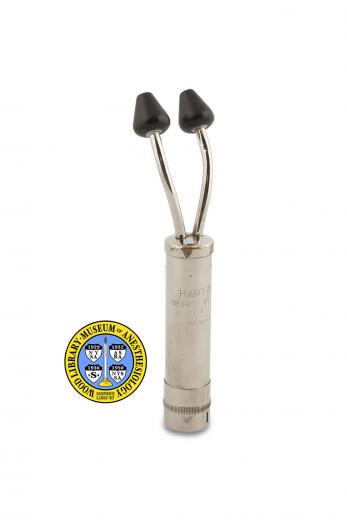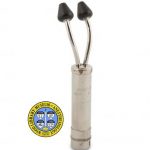Bennett Inhaler
The Bennett Obstetrical Chloroform Inhaler was introduced around 1910. Self-administration inhalers allow patients to administer medications, including anesthetics, to themselves. Since the 18th Century, they have been used to relieve ailments such as colds, headaches and asthma. Self-administration inhalers for women in labor were used in the early and mid-20th Century.
The handle of the inhaler is a hollow tube packed with cotton. The cotton would be soaked with chloroform before each procedure. The small size of this inhaler was suited to chloroform, because very little of it is need to produce analgesia. Some vendors marketed this inhaler for use with ether, but that would not have been effective. It would take more ether to do the job than the amount of cotton in this device could hold.
The patient would grasp it by the handle and inhale the vapors of chloroform from the two bulbs. These are large, and placed far apart, so that they cannot be inserted into the patient's nose, which might have led to an overdose. When a patient had inhaled enough vapor to become unconscious, he or she would drop the inhaler; this also helped to prevent an overdose.
Catalog Record: Bennett Inhaler
Access Key: akit
Accession No.: 2000-05-24-1
Title: [Obstetrical chloroform inhaler / by Dr. John F. Bennett.]
Author: Bennett, John F.
Corporate Author: J.F. Hartz Company.
Title variation: Alt Title
Title: Bennett’s inhaler.
Title variation: Alt Title
Title: Bennett obstetrical chloroform inhaler.
Publisher: Detroit : Hartz Co.; [1910-1950].
Physical Descript: 1 inhaler ; metal, rubber ; 14.5 x 4 x 2.5 cm.
Subject: Inhalers, Anesthesia.
Subject: Anesthesia, Obstetrical.
Subject: Analgesia, Obstetrical.
Subject: Chloroform.
Subject: Self Administration.
Note Type: General
Notes: Title based on the name of the inhaler in the earliest two publications
(advertisements) found in which the inhaler is referenced The early date
(1910) in the date range for the possible year of manufacture is based on the
date of the earliest publication found (an ad) that references the inhaler.
The end date is based on the museum registrar’s, and the cataloger’s, best
generous estimate. If definitely may have been manufactured before before
1950. This inhaler was not listed in the 1939 Hartz catalog titled,
“Catalogue of Sundries for the Physician, Nurse and Hospital.” The inhaler
was also not listed in the 1940 Hartz price list titled, “Physicians’
confidential net price list: effective from April 15, 1940.” The date range
could change if documentation indicates the range should be corrected.
Note Type: Citation
Notes: Bennett’s inhaler. Illustrations of Surgical Instruments of Superior Quality.
New York: Kny-Scheerer Company;1915:2001.
Note Type: Citation
Notes: Catalogue of Sundries for the Physician, Nurse and Hospital. Toronto,
Montreal: J. F. Hartz Co.; 1939.
Note Type: Citation
Notes: Jacobus M, Keller EF, Shuttleworth S. Body/Politics : Women and the
Discourses of Science. New York: Routledge; 1990:133.
Note Type: Citation
Notes: Obstetrical chloroform inhaler [advertisement]. Am J Clin Med. December,
1910;17(12):68 [of advertisements].
Note Type: Citation
Notes: Obstetrical chloroform inhaler [advertisement]. Am J Clin Med. February,
1911;18(2):62 [of advertisements].
Note Type: Citation
Notes: Physicians’ confidential net price list: effective from April 15, 1940.
Toronto: J.F. Hartz Co.; 1940.
Note Type: Physical Description
Notes: One chloroform inhaler composed of a hollow metal cylinder and two small
tubes for nasal inhalation; The cylinder measures approximately 8.5 cm in
length and 2 cm in diameter; The distal end of the cylinder is capped with a
metal piece, which can be removed to insert cotton wet with chloroform; The
two tubes are topped by black rubber pieces shaped for the nostrils;
Manufacturer’s marks are engraved on the cylinder; They include, “HARTZ CO.
[new line] DETROIT-CLEVELAND [new line] TORONTO [new line] PAT. APPL’D FOR”.
Note Type: Reproduction
Notes: Photographed by Mr. Steve Donisch on January 17, 2013.
Note Type: Acquisition
Notes: Donated to the WLM by George S. Bause, MD, the Wood Library-Museum of
Anesthesiology Honorary Curator.
Note Type: Historical
Notes: In 1910, most mothers in the United States still gave birth at home, so it’s easy to understand why the J.F. Hartz Company decided to manufacture this very simple and portable chloroform inhaler. In advertisements and catalogs the inhaler is referred to as the “Obstetrical Chloroform Inhaler By Dr. John F. Bennett”. Where Dr. Bennett worked is not indicated.
The inhaler was designed to be held by a woman in labor so that she could self-administer chloroform by placing the rubber pieces to her nostrils and inhaling. The following directions were provided in the advertisements, “Remove the cap. Place small piece of gauze (or absorbent cotton) in the reservoir. Saturate the gauze, or cotton, and hand the inhaler to the patient, who will inhale as much as necessary, and then involuntarily drop the instrument.” An ad for the inhaler, in the February, 1911 issue of “The American Journal of Clinical Medicine,” featured a photograph of a stylish woman, with Edwardian hair and blouse, demonstrating its use.
Until at least 1915, a physician could have the inhaler mailed to anywhere in the United States or Canada for $1.
This inhaler is not be confused with the better known Clover and Hewitt-like gas and ether inhaler developed by Thomas L. Bennett.
Note Type: Exhibition
Notes: Chosen for the WLM website (noted July 30, 2013).


